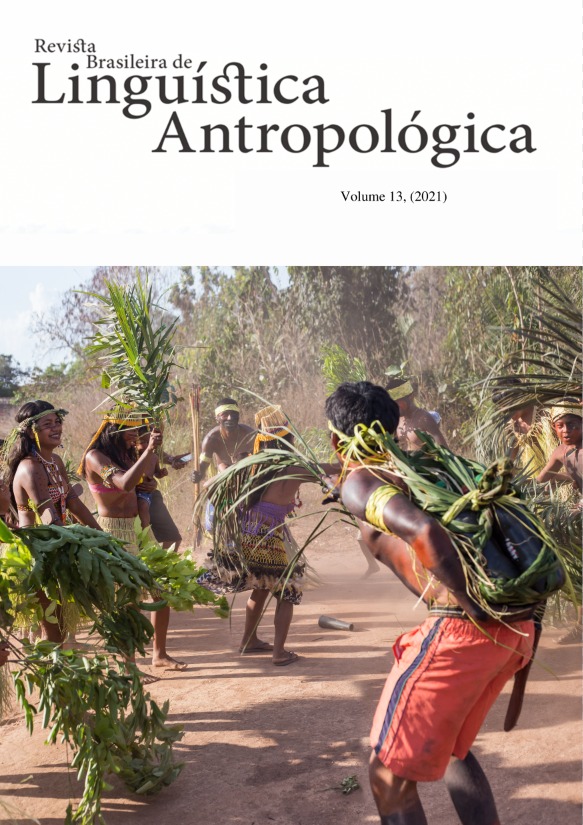The The syntactic status of noun incorporation in the tenetehára language (Tupi-Guarani family)
DOI:
https://doi.org/10.26512/rbla.v13i01.38034Keywords:
Família Tupí-Guaraní, Língua Tenetehára, Incorporação Nominal, Programa MinimalistaAbstract
This paper aims at proposing a theoretical analysis that explains the noun incorporation process in the Tenetehára language (Tupi-Guarani). Thus, we attempt to answer the question: based on the assumptions of the Minimalist Program (cf. Chomsky, 1993, 1995), what is the formal feature responsible for motivating noun incorporation in Tenetehára? We consider two types of noun incorporation in the language under analysis, namely: (i) transitive predicates which become formally intransitive verbs as the internal argument is incorporated; and (ii) in the instances of possessive structures in internal argument positions of intransitive and transitive verbs, verbal valence is preserved, since only the possessee noun is incorporated. As for the syntax of noun incorporations, based on Baker (1988), we lay the foundation for further investigation about this morphosyntactic phenomenon within a minimalist approach (cf. Chomsky 1993, 1995). In summary, we propose that, in the Tenetehára language, the driving force responsible for the incorporation of the noun into the head of a vP is the [+non-individuated] formal feature.
Downloads
References
Assmann, Anke, Doreen Georgi, and Philipp Weisser. 2012. A Minimalist analysis of possessor advancement Baker (1988) revisited. Proceedings of ConSOLE XIX. Leiden, South Holland.
Baker, Mark C. 1988. Incorporation: A Theory of Grammatical Function Changing. Chicago: University of Chicago Press.
Bobaljik, Jonathan. 1993. Ergativity and Ergative Unergatives. MIT working papers in linguistics 19:45-88.
Camargos, Quesler Fagundes. 2013. Estruturas causativas na língua Tenetehára: uma análise minimalista. Master’s dissertation, Federal University of Minas Gerais.
Camargos, Quesler Fagundes. 2017. Aplicativização, causativização e nominalização: uma análise unificada de estruturas argumentais em Tenetehára-Guajajára (Família Tupí-Guaraní). PhD thesis, Federal University of Minas Gerais.
Castro, Ricardo Campos, and Quesler Fagundes Camargos. 2018. Estruturas causativas, reflexivas, recíprocas e anticausativas na língua Tenetehára-Guajajára (Família Tupí-Guaraní). Revista Cadernos de Estudos Linguísticos da Universidade Estadual de Campinas 60(3):669-690.
Castro, Ricardo Campos. 2007. Interface morfologia e sintaxe em Tenetehára. Master’s dissertation, Federal University of Minas Gerais.
Castro, Ricardo Campos. 2013. O epifenômeno da alternância de valência na língua Tenetehára (Tupí-Guaraní). Revista da Anpoll 34:347-91.
Castro, Ricardo Campos. 2017. Morfossintaxe Tenetehára (Tupí-Guaraní). PhD thesis, Federal University of Minas Gerais.
Chomsky, Noam. 1981. Lectures on Government and Binding. Berlim and New York: Mouton de Gruyter.
Chomsky, Noam. 1993. A Minimalist Program for Syntactic Theory. In Ken Hale & Samuel Jay Keyser (Eds.), The View from Building 20, (pp. 1-52). Cambridge: The MIT Press.
Chomsky, Noam. 1995. The Minimalist Program. Cambridge: The MIT Press.
Duarte, Fábio Bonfim, and Ricardo Campos Castro. 2010. Incorporação nominal, inergatividade e estrutura causativa em Tenetehára. In Ana Suelly Arruda Cabral & Aryon Dall’Igna Rodrigues (Eds.), Línguas e Culturas Tupí. Brasília and Campinas: Curt Nimuendajú, pp. 43-62.
Duarte, Fábio Bonfim. 1997. Análise gramatical das orações da Língua Tembé. Master’s dissertation, University of Brasília.
Duarte, Fábio Bonfim. 2002. Negação e movimento do verbo na língua Tembé. In Ana Suelly Arruda Cabral & Aryon Dall’Igna Rodrigues (Eds.), Línguas indígenas brasileiras: fonologia, gramática e história. Belém: UFPA, pp. 374-84.
Duarte, Fábio Bonfim. 2003. Ordem dos constituintes e movimento em Tembé: minimalismo e anti-simetria. PhD thesis, Federal University of Minas Gerais.
Duarte, Fábio Bonfim. 2007. Estudos de morfossintaxe Tenetehára. Belo Horizonte: FALE/UFMG.
Duarte, Fábio Bonfim. 2013. Tenetehára: a predicate fronting Language. The Canadian Journal of Linguistics 57(3), 359-86.
Hale, Ken, and Samuel Jay Keyser. 1993. Aspect and the syntax of argument structure. Cambridge: The MIT Press.
Halle, Morris, and Alec Marantz. 1993. Distributed Morphology and the Pieces of Inflection. In Ken Hale & Samuel Jay Keyser (Eds.), The View from Building 20, (pp. 111-176). Cambridge: The MIT Press.
Klamer, Marian. 1998. A Grammar of Kambera. Berlim and New York: Mouton de Gruyter.
Laka, Itzar. 1993. Unergatives that assign ergatives, unaccusatives that assign accusatives. MIT working papers in linguistics 18:149-172.
Langacker, Ronald W. 1987. Nouns and verbs. Language 63(1), 53-94.
Mithun, Marianne. 1984. The evolution of noun incorporation. Language 60(4), 847-894.
Mufwene, Salikoko S. 1984. The count/mass distinction and the English lexicon. In David Testen & Veena Mishra (Eds.), Parasession on lexical semantics. Chicago: Chicago Linguistic Society, pp. 200-221.
Pavey, Emma L. 2010. The Structure of Language: An introduction to grammatical Analysis. Cambridge: Cambridge University Press.
Rodrigues, Aryon Dall’Igna. 1953. Morfologia do Verbo Tupi. Revista Letras 1:121-152.
Sadock, Jerrold M. 1980. Noun Incorporation in Greenlandic: A Case of Syntactic Word Formation. Language 56(2), 300-319.
Salas, Adalberto. 1992. El mapuche o araucano: fonología, gramática, y antología de cuentos. Madrid: Editorial MAPFRE.
Silva, Tabita Fernandes. 2010. História da língua Tenetehára: contribuição aos estudos histórico-comparativos sobre a diversificação da família Tupí-Guaraní do tronco Tupí. PhD thesis, University of Brasília.
Vieira, Márcia Maria Damaso. 2010. Os núcleos aplicativos e as línguas indígenas brasileiras. Revista de Estudos da Linguagem 18(1), 141-64.
Wisniewski, Edward J., Christopher A. Lamb, and Erica L. Middleton. 2003. On the conceptual basis for the count and mass noun distinction. Language and Cognitive Processes 18:583-624.
Downloads
Published
How to Cite
Issue
Section
License
Copyright (c) 2021 Revista Brasileira de Linguística Antropológica

This work is licensed under a Creative Commons Attribution 4.0 International License.
Authors who publish in RBLA agree to the following terms:
a) Authors maintain the copyright and grant the journal the right of first publication, and the work is simultaneously licensed under the Creative Commons Attribution License, which allows the sharing of the work with recognition of the authorship of the work and initial publication in this journal.
b) Authors are authorized to assume additional contracts separately, for non-exclusive distribution of the version of the work published in this journal (eg, publish in an institutional repository or as a book chapter), with recognition of authorship and initial publication in this journal.
c) Authors are allowed and encouraged to publish their work online (eg, in institutional repositories or on their personal page) at any point before or during the editorial process, as this can generate productive changes, as well as increase impact and citation of the published work.







